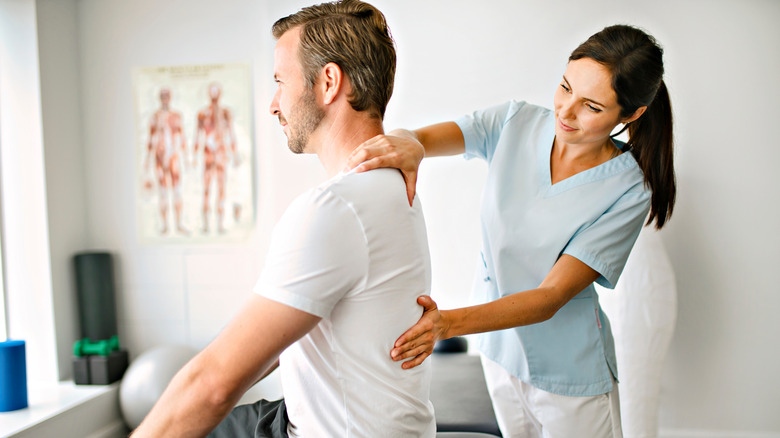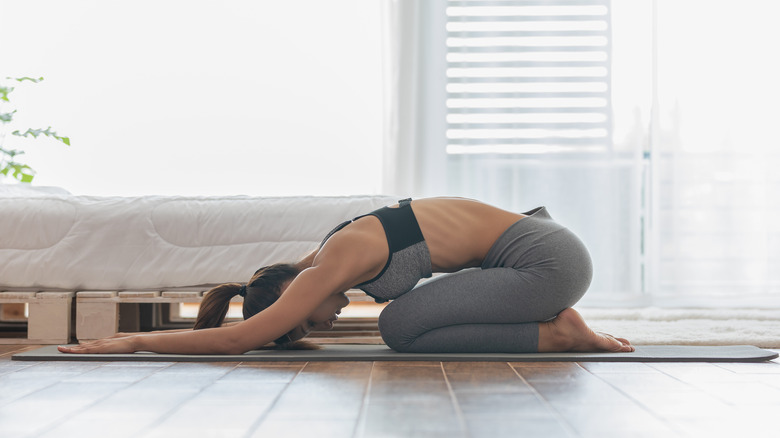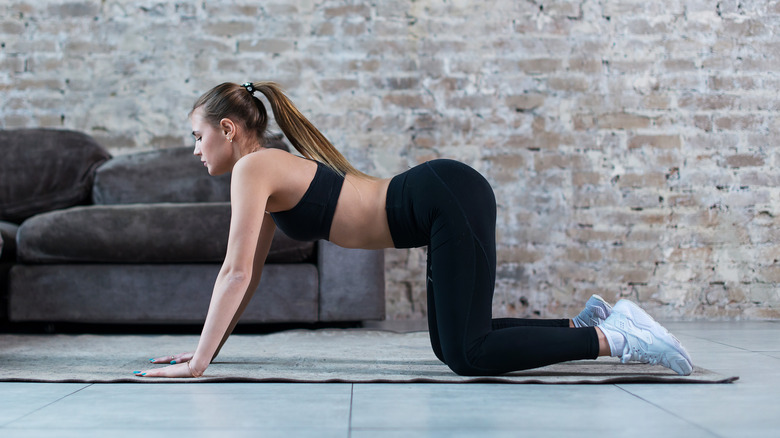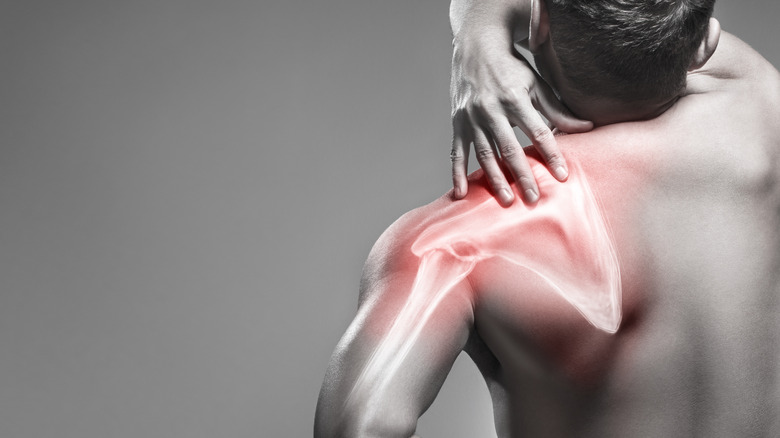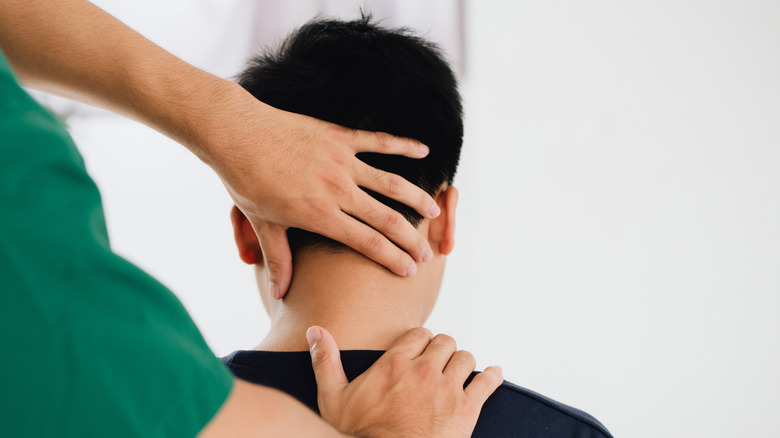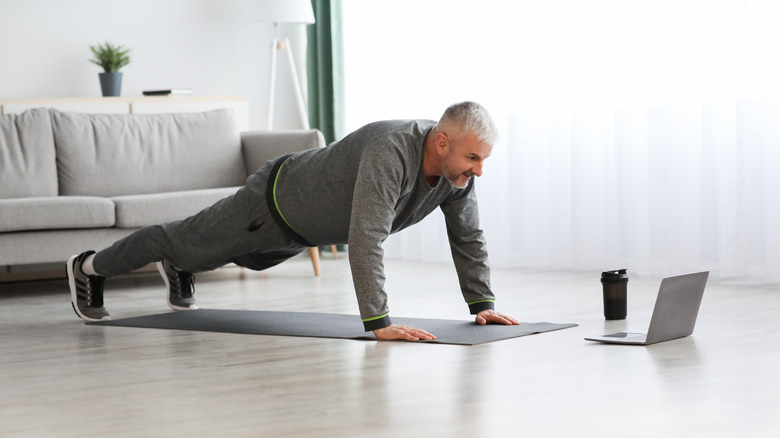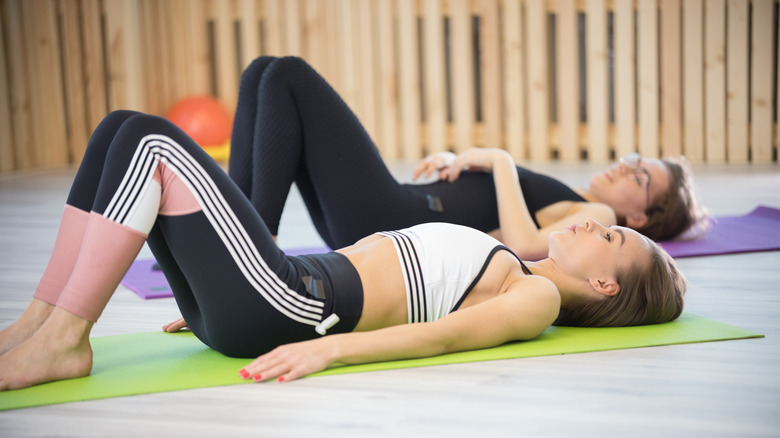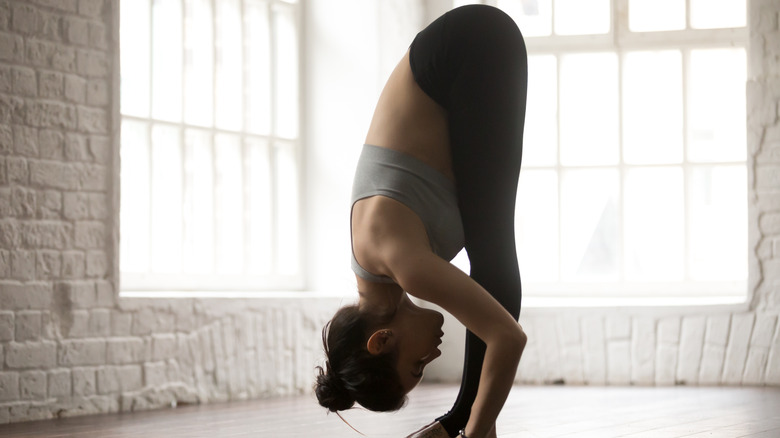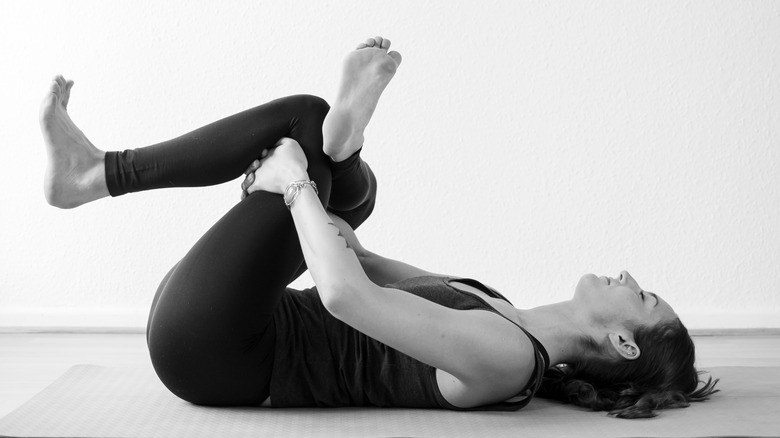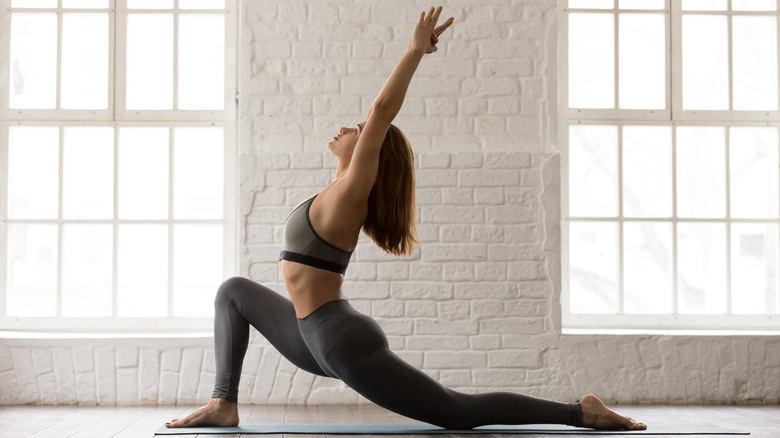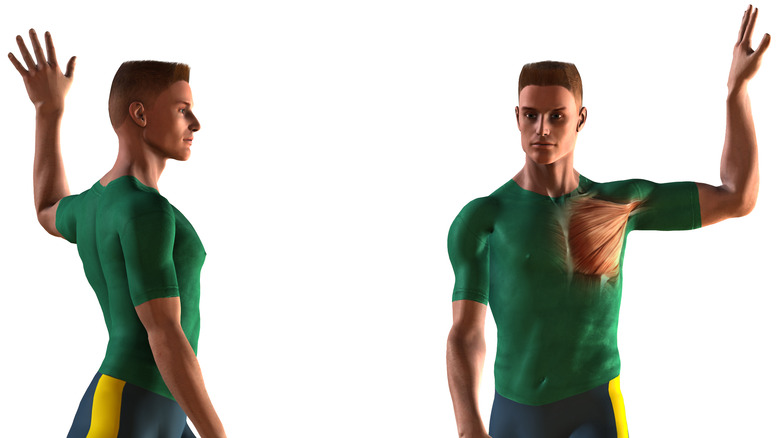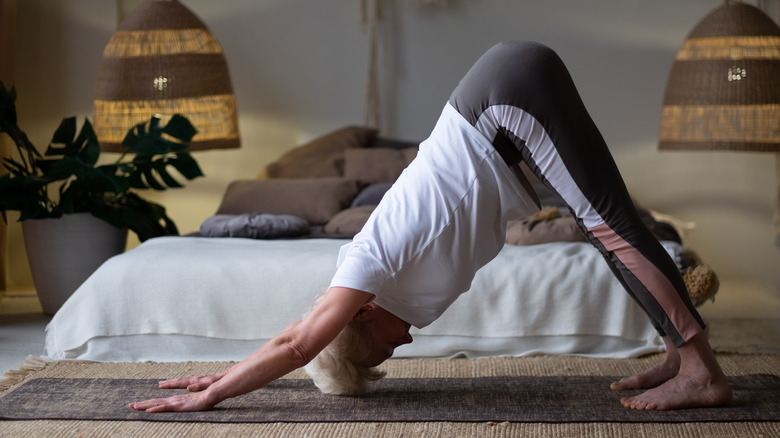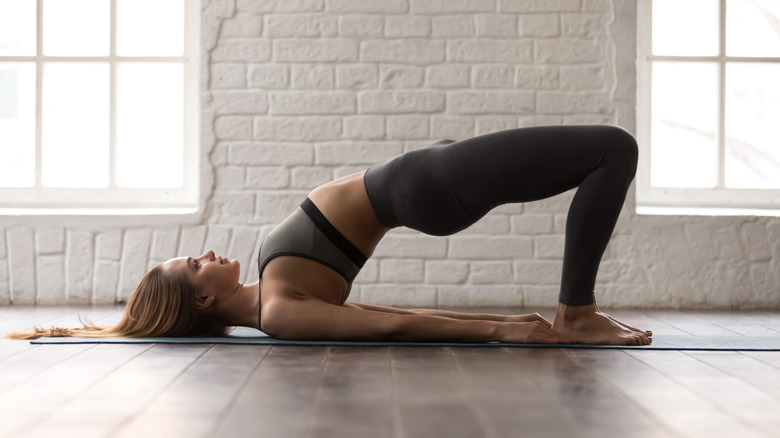Exercises You Need To Try If You Have Bad Posture
While working at a desk in an office is hard on our posture, the work-from-home era has annihilated the structural spinal support that our bodies desperately need (via Hospital for Special Surgery). Beyond that, about a gazillion different elements can affect our posture, from chronic slouching to your favorite high heels and more (via American Chiropractic Association). Even the slightest niggle can turn into a significant postural imbalance over time.
Our spines are literally the backbones of our bodies. It is up to us to strengthen the surrounding musculature appropriately and evenly. Proper posture can make a huge difference when it comes to alleviating aches and pains, which is part of the reason that it is such a high priority to rectify when improper. By keeping your posture upright, strong, and aligned, you will be better able to avoid injuries, both from habited poor movement patterns or from epic tumbles (via Healthline). The general rule of thumb is that the more flexible your muscles and connective tissues are, the less likely you are to get injured. Think about it — if you consistently move your joints through their full ranges of motion, catching yourself during a fall could be a far less harrowing experience. With this in mind, we rounded up some of the best posture-correcting exercises, according to physical therapists and other leading experts.
Child's pose
If you have been to a yoga class, chances are you have been introduced to child's pose. Child's pose is restorative, comfortable for most, and often offered as a resting posture in vigorous vinyasa classes and relaxing restorative practices (via Yoga Journal). This pose earned its name because the configuration of the spine while in it mimics the natural curvature of a baby's developing spine while in utero, as explained to Health Digest by Jessica Jones, physical therapist and owner of Emerald Bay Physical Therapy.
Spending a few minutes every day in child's pose is a great attribute to any posture-correcting regimen because of how many muscle groups it lengthens all at once (via Healthline). It lengthens the muscles around your spine, mostly. But depending on how you choose to configure this pose, it can also stretch your glutes, quads, and even your inner thigh muscles. To perform child's pose, you'll begin by sitting on your shins and allowing your hips to sink down onto your heels. The closer together your knees are, the more of a lower-back emphasis you will achieve in this stretch. Keeping your hips where they are, you'll sink your chest forward and crawl your hands forward. Once you find a gentle stretch in a comfortable expression of this position, you'll rest there. Drawing in deep breaths and allowing your body weight to grow heavier during each exhalation is a great way to fully reap the benefits of child's pose.
Cat cow
Cat cow, also called cat camel, is a great mobility-improving movement that can help lengthen the muscles that surround your spine, as Jessica Jones, MPT told Health Digest. By encouraging the facet joints, AKA spinal joints, to move through their entire ranges of motion, they will be more equipped to help keep you upright. If we neglect to move these joints and stretch the muscles surrounding them. In that case, we can often develop habited bad posture or movement patterns, which can cause one muscle group to tighten, leading to an imbalance and potentially poor posture if not corrected.
To perform perfect cat cows, you'll begin on all fours (via Healthline). You'll place your wrists directly beneath your shoulders and your knees directly beneath your hips. As you inhale, you'll lift your chest toward the front of the room and your eyes toward the ceiling. You'll send your hips up while dropping your belly down. To reverse it and enter the cat phase on an exhalation (easy to remember because your back takes on the shape of a classic Halloween cat), you'll press the ground away from you through your hands, pull your belly up, and draw your chin toward your chest. Follow the rhythm of your breath as you move through a comfortable number of repetitions every day — your spine will thank you!
Scapular retraction
Your scapulae are the triangle-shaped "shoulder blade" bones that you can feel on your back (via Science Direct). These bones are connected to a ton of different muscles that enable you to move your arm in all of its many ways. Still, these muscles can also cause postural complications if not cared for appropriately (via Journal of Physical Therapy Science). Sitting on our phones or computers all day often has us rounding our shoulders forward, which can weaken the muscles that draw your shoulder blades back toward each other. It is valuable to perform scapular retractions to counteract this effect.
To correctly do this exercise, stand or sit up super tall with your shoulder blades back and down (per Rose Physical Therapy Group). With your elbows bent at a 90-degree angle but secured firmly at your sides, you'll draw your shoulder blades together behind you. It is valuable to envision that you are trying to squeeze someone's finger in between the scapulae. The easiest way to build strength initially is to perform this exercise isometrically, meaning that you initiate the muscular contraction and then hold it for a 5-10 count. Performing three sets of ten reps is a great place to start for ultimate posture-building purposes. If you have an exercise band, you can hold that in between your hands for a bit of added tension and more of a challenge.
As a pro tip, it is best to perform this exercise in front of a mirror to ensure that your shoulders stay even with each other and that your chin stays level. The feedback of a mirror is great for helping to rectify postural imbalances.
Levator scapulae stretch
Your levator scapulae live atop your scapula, or shoulder blade, and run vertically up toward the back of your neck from there (via The Healthy). This bilateral set of muscles is tasked with allowing us to shrug our shoulders. As we sit, stare at our devices, and allow our upper backs to round, these muscles begin to shorten and tighten up. As this happens, we begin to lose our natural abilities to stand up straight and maintain correct posture in our cervical spines. It is incredibly beneficial to remember that posture runs the entire spine length. With that in mind, try a levator scapulae stretch to loosen your neck and help promote a healthy curvature of your upper spine.
To stretch your levator scapulae, begin by sitting on an even, sturdy chair with proper posture. To stretch the right side, use your right hand to grab onto the chair below your hip. Turn your head slightly and bring your gaze down toward your left pocket. To stretch the left side, perform the same action with the opposite hands. Keep your spine long and tall while creating opposing energies on either side of the muscle you are attempting to stretch. If you need a bit more biofeedback, you can take your loose hand to the top side of your head on the opposite side and gently encourage it to move further in the direction it is turned. Hold for about thirty seconds, three times on each side, for best results.
Planks
Whether you love to hate 'em or hate to love 'em, the humble plank can do wonders to help correct postural issues (via Healthline). Planks can be performed on your elbows or your hands, but for our purposes, we will discuss a "high" plank, or planking on our hands. Not only does this strength-building position require a keen awareness of where your spine is in space, but it also provides huge core-strength gains. Core strength is a crucial part of maintaining correct posture. When you think about the corset of muscles you have surrounding your torso, it makes sense that building them up will help keep you, well, up!
A high plank is essentially the top portion of a push-up. You can definitely execute it either on your toes or your knees if you'd prefer a modified version. Per Healthline's instructions, press energy back through your heels to ensure that your lower body is an active participant. They recommend gently guiding your head forward to create space between your head and shoulders and ensure that you are keeping your chest from sinking down toward the ground. Do three to five rounds, holding for about ten breaths each for best results. But don't be afraid to modify or minimize the rep scheme if you cannot maintain proper alignment; after all, holding planks with bad form to help improve posture won't exactly help you achieve your goal.
Knee rolls
Knee rolls, sometimes called "windshield wipers," are an incredibly beneficial exercise to help maintain mobility in the lower back, and thus posture. At first, this movement might not feel like it is "doing anything," but don't underestimate its power. By intentionally rocking our knees from side to side, we can actually increase synovial fluid production in the facet joints of our lower spine, according to physical therapist Jessica Jones. The more synovial fluid we have in our joints, the easier it is for them to slide and glide the way they are intended to. "You can think of knee rolls as a way to lubricate the structures in the lower part of your back," Jones told Health Digest.
To perform knee rolls, you'll begin by lying on your back with your knees comfortably bent and your feet planted on the ground (per Sports Injury Clinic). Super gently, you'll draw your belly button in toward your spine and begin to rock your knees to one side and then the other. You will want to maintain deep breaths and this gentle engagement of the core throughout the exercise. Always move within your comfortable range of motion and enjoy the lower back-stretching that this movement provides.
Standing forward fold
Standing forward folds are one stretch that might make you taller. Well, not really, but doing them on the reg is likely to make you feel taller because it can help lengthen out your spine. As you find your way into relaxation in a forward fold, you'll be able to release a ton of tension throughout the entire back side of your body from your neck down to your hamstrings (via Healthline).
To find your perfect standing forward fold, start with your feet firmly planted at about hip's width apart. Hinge from your hips as you bend forward and allow the crown of your head to extend down toward the ground. If the sensation in your lower back or hamstrings is too intense, find a gentle bend through your knees and emphasize the rag-doll sensation of the upper body. By bending the knees a bit, you will allow your lower back to relax more, leading to a better stretch throughout the entire back-body. You can draw the kneecaps up slightly to engage the quads slightly when you are ready to dive into a hamstring-lengthening version. Take some deep breaths as you hang in this pose, and remember to emphasize your exhalation as you slowly come out of the posture, so you don't get dizzy.
Glute stretch
The glute stretch is one of the kings of postural work, even though the glutes exist in our butts and not exactly near our spines (per South Lake Wellness and Injury Clinic). They are connected, and if your glutes are out of whack, it could spell trouble for the integrity of your entire hip girdle, which is very much connected to your spinal column. Sitting a lot can affect the strength and length of your glutes. If your glutes atrophy, they can be overridden by tight hip flexors. If your hip flexors end up in charge, your entire upper body will begin to pitch forward at the hips and create atypical shapes through the pelvis and lower spine, which, as you can imagine, is the antithesis of proper, upright posture.
To perform your glute stretch, you'll begin by lying on your back (via Self). To stretch the right side, bend your left knee up toward you and place your right ankle on the left knee. Gently bind onto the backside of the left leg and hug the whole bundle toward you until you light up a stretch in your right butt cheek. It is valuable to protect the integrity of the knee joint by flexing your right foot and energetically pressing the right knee away from you. To stretch the left side, switch legs. Keep breathing as you enjoy this stretch on both sides of your body.
Hip flexor stretch
Your hip flexors are essentially what links your upper body to your lower body (via Verywell Health). Aptly named, the hip flexor muscles create flexion through your hips. Unfortunately, sitting in chairs and cars for most of the day can lead to these suckers tightening up like WHOA. If you fail to give your hip flexors the attention they need, the tension that is naturally created in them could lead to an anterior tilt in the pelvis, which could lead to significant postural imbalances.
To get a deep hip flexor stretch, you'll begin by taking a knee (per Medical News Today). Draw your belly button in toward your spine and lift through the crown of your head to ensure you are beginning with proper posture. Gently sink into your front knee, keeping your front heel planted on the mat. By keeping your chest and upper body lifted, you should be able to connect with a stretch through the front side of your back leg. As with many stretches, your best bet is to hold each stretch for about thirty seconds twice on each side.
Pectoralis stretch
Much like the glutes, the pecs are another muscle group that does not necessarily touch the spine but can have a huge impact on posture (via The Healthy). Too much sitting and screen-looking can cause us to hunch forward with rounded shoulders for large chunks of the day. While this poor posture certainly affects the cervical spine and the back side of the body, it can also cause our pecs to tighten up and contribute to this rounded posture. This is especially true if we do not take the time to unwind these tense muscle fibers at regular intervals.
The Healthy recommends performing this pectoral stretch after an upper-body workout while your muscles are warm. But if you aren't into that, doing it at any point is better than skipping over it. To stretch your pecs, stand squarely facing a wall or a post. Place your flat palm on the stable surface in front of you, a bit lower than your shoulder, and gently begin to rotate your body away from your hand. Fairly quickly, you should become aware of a stretching sensation in the chest and front side of the shoulder. Be mindful of not pushing yourself into this stretch too aggressively, and remember to breathe while you hold it for at least thirty seconds twice on each side.
Reverse shoulder circles
Reverse shoulder circles might seem like the easiest exercise in the universe. But if you are struggling with your posture and aren't doing them, it's time to get started. On the most basic level, simply rolling our shoulders backward can help counteract the effect that perpetually rolling them forward all day has (via Verywell Fit). Not only that, but encouraging movement through the shoulders can increase circulation and blood flow, providing more oxygen and nutrients to the surrounding muscle groups.
As explained to Health Digest by Jessica Jones, to perform shoulder circles, you'll start by sitting up or standing up tall — with exceptional posture, of course. You'll then roll your shoulders backward and around, making as small or as big of circles as you want. You can even change the size of the circles you're making at any time! Repeat about thirty times a few times per day and enjoy the benefits. No need to reverse the reverse shoulder circles and do forward circles. Rolling your shoulders forward only accentuates the hunched posture we are trying to correct.
Downward facing dog
Downward facing dog is a staple pose in yoga classes; it acts as a foundation, a resting posture, a strength-building posture, a transitional posture, and more (via Yoga Journal). But daily downward dogging can help you maintain a healthy spine and good posture as well. Much like performing shoulder circles and stretching the pec muscles downward dog can help open the front sides of the shoulders, which is an area that is particularly susceptible to tightening and causing issues if you look at your phone or computer all day long (via Healthline).
To execute a comfortable downward facing dog, Healthline recommends beginning on all fours. To keep your wrists safe, make sure that you spread your fingers as wide as possible and take the bulk of the weight through your thumbs and index fingers. Pike your hips to the sky to make a triangle shape with your body. Allow your heels to sink down toward the floor — it doesn't matter if they actually touch the ground. Release the tension in your neck and allow your eyes to travel back to the space between your feet. Take some deep, intentional breaths here, and just let this ubiquitous yoga pose do its thang for your posture.
Glute squeezes
Stretching the gluteus muscles is important, but strengthening them is also valuable for maintaining solid posture (via Insider). Strengthening your glutes does not have to look like all of the Instagram fitness influencers who are hip-thrusting huge amounts of weight, though. It can be super subtle — so subtle, in fact, that no one except you even needs to know that you are doing it. For postural purposes, simply engaging in some isometric glute squeezes will help you stand up tall.
Glute squeezes can be executed from different positions (via Healthline). Still, it is easiest to find the right engagement when you begin lying on your back. Bend your knees so that your feet are planted firmly on the ground, and then squeeze your butt. Seriously, that it is. Imagine that you are trying to crack a walnut between your butt cheeks and go to town. According to Healthline, a good rep scheme to start with is a 10-second isometric hold to release for one minute. They recommend setting an alarm and performing this isometric hold once an hour.
Thoracic rotations
Many posture-correcting exercises emphasize the lower, or lumbar, spine or the cervical, or upper, spine. But there is an entire chunk of a very important spine in the middle called the "thoracic" spine (via Spine-health). This middle portion of your spine is comprised of 12 vertebrae. As you can venture to assume, the health of these joints and the surrounding musculature can largely affect your posture. Sometimes called half rolls, sometimes called open book stretches, but often called thoracic rotations, this movement is a total game-changer when it comes to pursuing your journey to impeccable posture, Jessica Jones told Health Digest.
To perform thoracic rotations, you'll begin lying on your side with your knees bent comfortably and your arms extended out in front of you, palms stacked neatly atop one another (via Rose Physical Therapy Group). If you are lying on your left side, you'll lift your right arm as if you are drawing a rainbow in the sky. Following the line of this imaginary arc, you'll bring the right hand back to the ground or mat behind you. If it feels uncomfortable to find the full expression, just bring the upper arm as far back as feels comfortable in your body. The key here is that your eyes have to follow your upper thumb to the best of your abilities. If you neglect to rotate the head, you will be missing out on much of the necessary thoracic rotation. Moving slowly and with intentional breath, you'll draw your rainbow across the sky again to return your hand to the starting position. Rose Physical Therapy Group recommends holding each repetition for about 10 seconds before returning to the starting position for a total of two to three minutes on each side.
